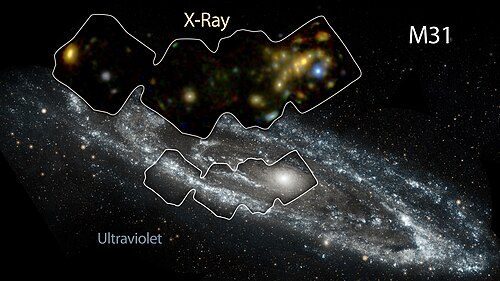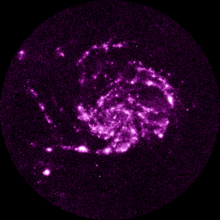Ultraviolet astronomy

Ultraviolet astronomy is the observation of electromagnetic radiation at ultraviolet wavelengths between approximately 10 and 320 nanometres; shorter wavelengths—higher energy photons—are studied by X-ray astronomy and gamma ray astronomy.[1] Light at these wavelengths is absorbed by the Earth's atmosphere, so observations at these wavelengths must be performed from the upper atmosphere or from space.[1]
Ultraviolet line spectrum measurements are used to discern the chemical composition, densities, and temperatures of the interstellar medium, and the temperature and composition of hot young stars. UV observations can also provide essential information about the evolution of galaxies.
The ultraviolet Universe looks quite different from the familiar stars and galaxies seen in visible light. Most stars are actually relatively cool objects emitting much of their electromagnetic radiation in the visible or near-infrared part of the spectrum. Ultraviolet radiation is the signature of hotter objects, typically in the early and late stages of their evolution. In the Earth's sky seen in ultraviolet light, most stars would fade in prominence. Some very young massive stars and some very old stars and galaxies, growing hotter and producing higher-energy radiation near their birth or death, wouldnbe visible. Clouds of gas and dust would block the vision in many directions along the Milky Way.
The Hubble Space Telescope and FUSE have been the most recent major space telescopes to view the near and far UV spectrum of the sky, though other UV instruments have flown on sounding rockets and the Space Shuttle.
Charles Stuart Bowyer is generally given credit for starting this field.

Ultraviolet space telescopes

 - Far Ultraviolet Camera/Spectrograph on Apollo 16 (April 1972)
- Far Ultraviolet Camera/Spectrograph on Apollo 16 (April 1972) + ESRO - TD-1A (135-286 nm; 1972–74)
+ ESRO - TD-1A (135-286 nm; 1972–74) - Orbiting Astronomical Observatory (#2:1968-73. #3:1972-81)
- Orbiting Astronomical Observatory (#2:1968-73. #3:1972-81) - Orion 1 and Orion 2 Space Observatories (#1:1971; 200-380 nm spectra; #2:1973; 200-300 nm spectra)
- Orion 1 and Orion 2 Space Observatories (#1:1971; 200-380 nm spectra; #2:1973; 200-300 nm spectra) +
+  - Astronomical Netherlands Satellite (150-330 nm, 1974–76)
- Astronomical Netherlands Satellite (150-330 nm, 1974–76) + ESA - International Ultraviolet Explorer (115-320 nm spectra, 1978–96)
+ ESA - International Ultraviolet Explorer (115-320 nm spectra, 1978–96) - Astron-1 (1983–89; 150-350 nm)
- Astron-1 (1983–89; 150-350 nm) - Glazar 1 & 2 on Mir (in Kvant-1, 1987-2001)
- Glazar 1 & 2 on Mir (in Kvant-1, 1987-2001) - EUVE (7-76 nm, 1992-2001)
- EUVE (7-76 nm, 1992-2001) - FUSE (90.5-119.5 nm, 1999-2007)
- FUSE (90.5-119.5 nm, 1999-2007) + ESA - Extreme ultraviolet Imaging Telescope (on SOHO imaging sun at 17.1, 19.5, 28.4, and 30.4 nm)
+ ESA - Extreme ultraviolet Imaging Telescope (on SOHO imaging sun at 17.1, 19.5, 28.4, and 30.4 nm) - GALEX (135-280 nm, 2003-2013)
- GALEX (135-280 nm, 2003-2013) + ESA - Hubble Space Telescope (Hubble STIS 1997–115–1030 nm) (Hubble WFC3 2009–200-1700 nm)
+ ESA - Hubble Space Telescope (Hubble STIS 1997–115–1030 nm) (Hubble WFC3 2009–200-1700 nm) - Swift Gamma-Ray Burst Mission (170–650 nm spectra, 2004-- )
- Swift Gamma-Ray Burst Mission (170–650 nm spectra, 2004-- ) - Hopkins Ultraviolet Telescope (flew in 1990 and 1995)
- Hopkins Ultraviolet Telescope (flew in 1990 and 1995) - ROSAT XUV[2] (17-210eV) (30-6 nm, 1990-1999)
- ROSAT XUV[2] (17-210eV) (30-6 nm, 1990-1999) - Public Telescope (PST)[3][4][5] (100-180 nm, Launch planned 2019)
- Public Telescope (PST)[3][4][5] (100-180 nm, Launch planned 2019) - Astrosat (130-530 nm, launched in September 2015)
- Astrosat (130-530 nm, launched in September 2015)
See also List of space telescopes#Ultraviolet
See also
References
- ^ a b A. N. Cox, ed. (2000). Allen's Astrophysical Quantities. New York: Springer-Verlag. ISBN 0-387-98746-0.
- ^ R. Staubert, H. Brunner,1 H.-C. Kreysing - The German ROSAT XUV Data Center and a ROSAT XUV Pointed Phase Source Catalogue (1996)
- ^ Public Telescope Project
- ^ The first public space telescope Popular Astronomy UK
- ^ Ein privates Weltraumteleskope für Amateure und Profis Spektrum DE
